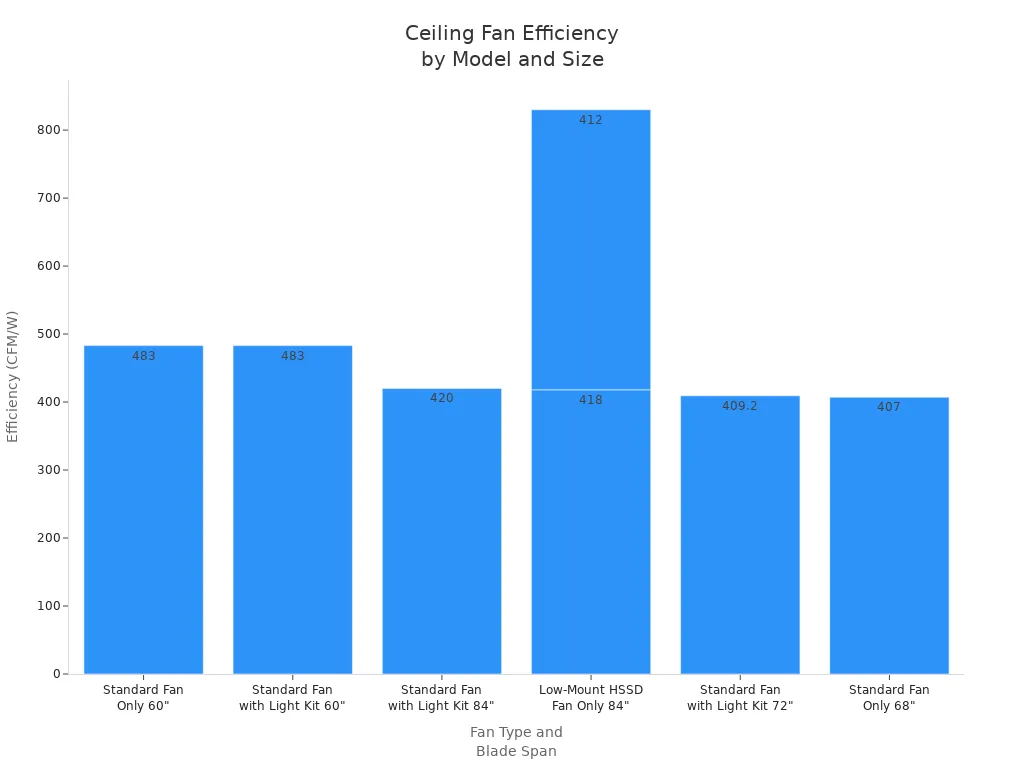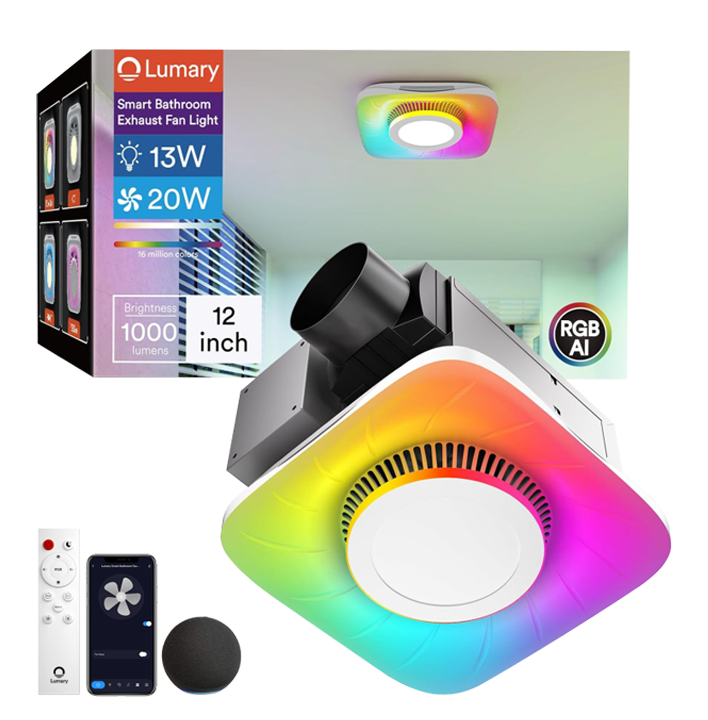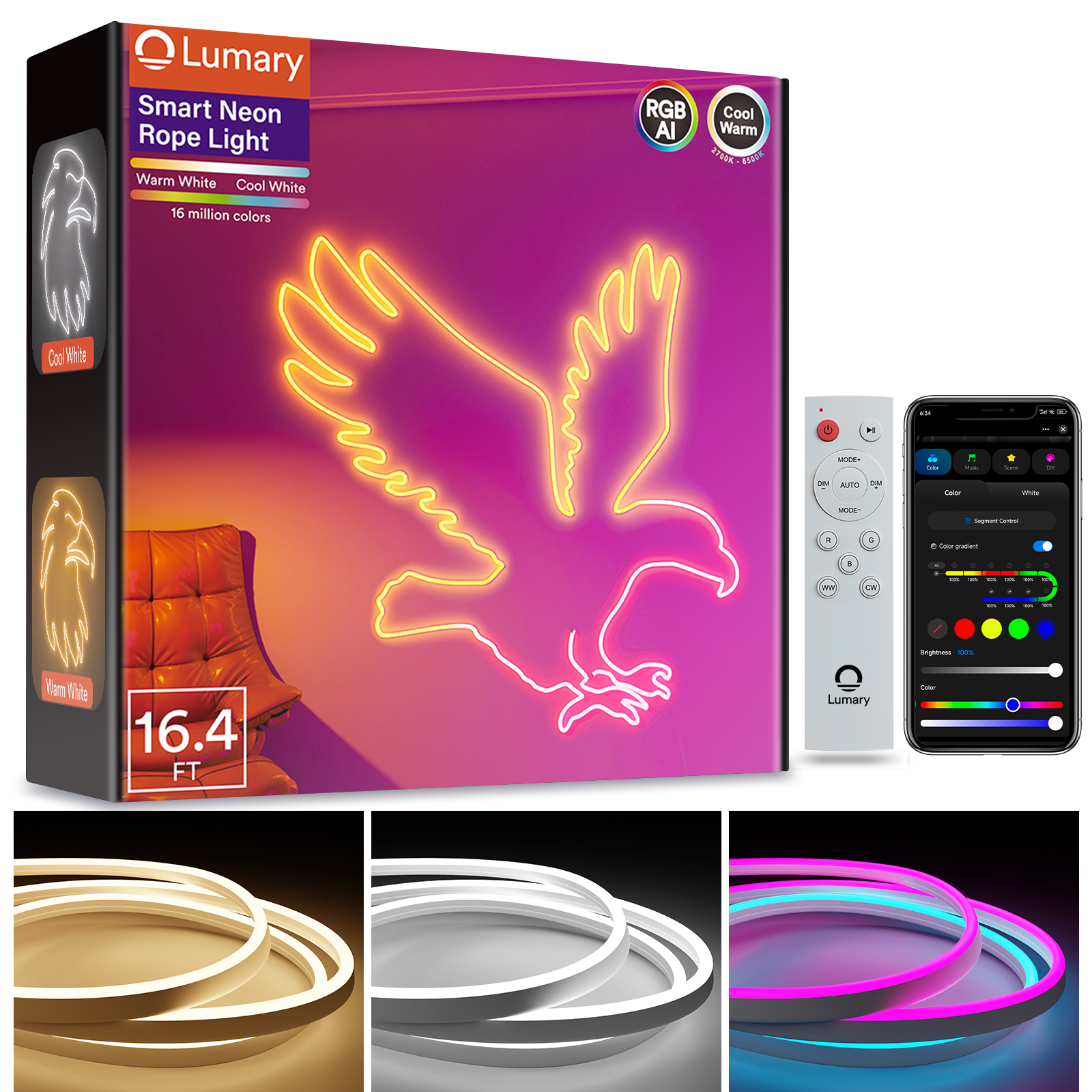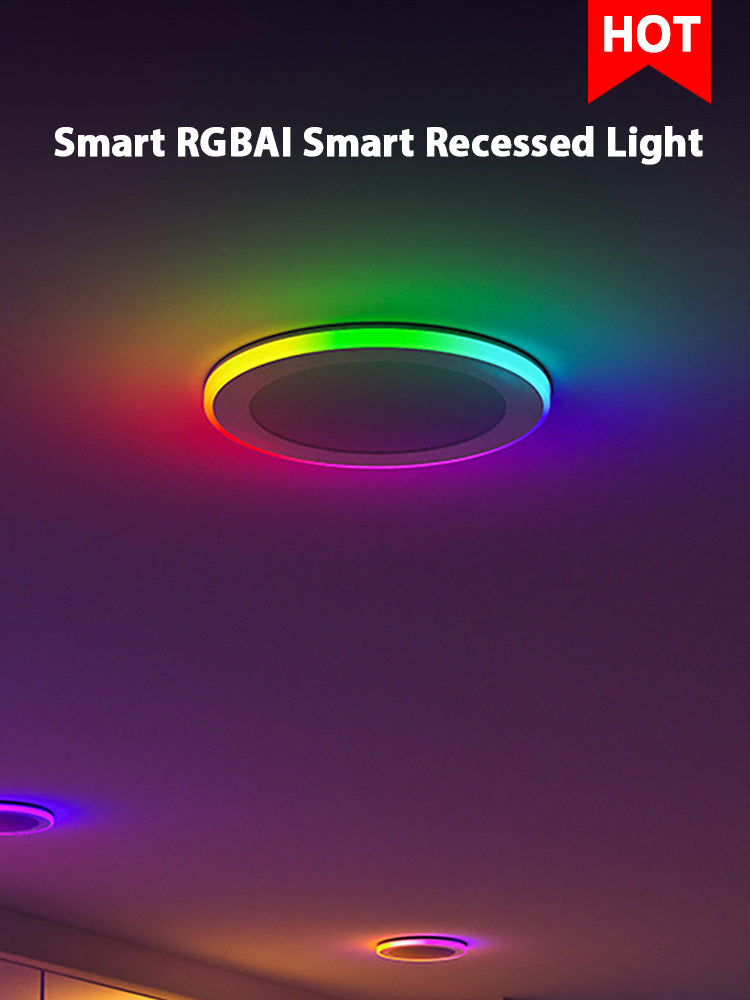Have you ever installed ceiling fans that just didn’t fit your rooms? Maybe the fan felt too small or made the space too noisy. When you choose a ceiling fan, you want it to keep you cool and blend with your aesthetic. The wrong size or speed can make you uncomfortable, waste energy, or even distract you with extra noise. If you want to match the fan to the room and boost both comfort and aesthetic, a few simple tips will help you choose the right ceiling fan every time.

Key Takeaways
-
Measure your room’s length, width, and ceiling height. This helps you pick the right fan size. The right size gives good airflow and keeps you safe.
-
Use the fan size guide to choose a blade span. Make sure it matches your room’s square footage. This helps you stay comfortable and saves energy.
-
Pick a ceiling fan style that matches your room’s decor. Choose the right blade count and finish too. This makes your room look nice and balanced.
-
Pick fans with quiet motors and energy-saving features. Smart controls can help you save money. These things also make your room more comfortable.
-
Install your fan the right way using the correct mount. Use the right mount for your ceiling height. Call a professional if the job is hard.

Ceiling Fan Size
Choosing the right ceiling fan size can make a huge difference in how comfortable your rooms feel. If you pick a fan that's too small, you might not get enough air circulation. If you go too big, the fan could overwhelm the space or even make it drafty. Let’s break down the steps and tips you need to size the fan to your room.
Measure Your Room
Before you start shopping for ceiling fans, grab a tape measure and a calculator. You’ll want to know your room size and ceiling height. Here’s how you can do it:
-
Measure the length of your room from one wall to the opposite wall.
-
Measure the width by going from one side to the other, perpendicular to your length measurement.
-
Multiply the length by the width to get your room’s square footage. For example, if your room is 12 feet by 14 feet, you have 168 square feet.
-
For rooms with odd shapes, like L-shaped spaces, break them into rectangles. Measure each part, then add the areas together.
-
Don’t forget to measure your ceiling height. This helps you pick the right mounting type for your fan.
Tip: Use a ladder if you need to reach high spots, and double-check your math with a calculator. Accurate measurements make it much easier to find a fan appropriate for your room size.
Fan Size Guide
Now that you know your room size, you can use a quick reference table to find the best ceiling fan size. The blade span (measured from tip to tip) is the key factor. Here’s a handy guide:
|
Room Size (Square Feet) |
Recommended Ceiling Fan Blade Span (Diameter) |
Typical Room Examples |
|---|---|---|
|
Up to 75 sq ft |
29" – 36" |
Small bathrooms, laundry rooms, walk-in closets |
|
76 – 144 sq ft |
36" – 42" |
Standard bedrooms, home offices, kitchen nooks |
|
145 – 225 sq ft |
44" – 50" |
Master bedrooms, medium living rooms, dining rooms |
|
226 – 400 sq ft |
50" – 54" |
Large living rooms, great rooms, large kitchens |
|
Over 400 sq ft |
56"+ |
Very large rooms, open floor plans, lofts |

-
For small rooms, stick with fans that have a blade span between 29 and 36 inches.
-
Medium rooms work best with fans in the 36 to 42-inch range.
-
Large rooms need a bigger fan, usually 44 to 54 inches.
-
Extra-large rooms or open spaces over 400 square feet may need a fan with a 56-inch blade span or even multiple ceiling fans for the best indoor air circulation.
Tip: If your room size falls between two categories, go with the larger fan for better air movement. For very large rooms, using two or more fans can help you achieve optimal airflow.
Ceiling Height and Clearance
Ceiling height matters just as much as room size when picking ceiling fans. You want to make sure your fan is safe and works well.
-
Always install ceiling fan blades at least 7 feet above the floor. This keeps everyone safe and avoids accidents.
-
For ceilings lower than 8 feet, choose a flush-mount or "hugger" fan. These types keep the blades close to the ceiling, usually 5 to 7 inches away.
-
If your ceiling is 8 feet or higher, you can use a standard downrod mount. This type usually places the blades about 12 inches from the ceiling, which helps with air circulation.
-
Leave at least 30 inches of space between the fan blades and any walls, doors, or cabinets. This gives the fan room to move air without hitting anything.
-
For rooms with high or vaulted ceilings, use a longer downrod to keep the fan at the right height—between 8 and 9 feet above the floor is ideal for most rooms.
Remember, following these tips ensures your ceiling fan size is appropriate for your room size and ceiling height. This way, you get the best comfort, safety, and energy efficiency.

Ceiling Fan Style
Choosing the right ceiling fan style can transform your space. You want a fan that not only keeps you cool but also fits your room’s look and feel. Let’s break down how you can match your fan to your decor, pick the best blade count and shape, and select finishes and colors that suit your style.
Match Your Decor
Start by looking at your room’s design theme. Every space has its own vibe, and your ceiling fan should blend in or stand out in a way that feels intentional. Here are some popular ceiling fan styles you’ll see in today’s homes:
-
Modern ceiling fans have sleek lines and minimal details. You’ll often find brushed steel or matte black finishes. These fans work well in contemporary or industrial rooms.
-
Traditional ceiling fans feature wood or bronze finishes and decorative touches. They fit classic interiors with rich colors and elegant furniture.
-
Tropical ceiling fans use natural materials like rattan or wood. The blades might look like banana leaves. These fans are perfect for outdoor spaces or rooms with a warm, relaxed feel.
-
Classic white ceiling fans are simple and blend into white ceilings. They work in almost any room, especially if you want the fan to disappear into the background.
To match your fan to your decor, follow these tips:
-
Think about the size of your fan. A large, decorative fan can become the focal point of a room, while a smaller, simple fan keeps things feeling open.
-
Decide if you want your fan to match your room’s style or create contrast. Sometimes, a modern fan in a traditional room adds a fun twist.
-
Stick to your room’s color scheme. Choose a fan that complements the main colors in your space, even if it’s just in the accents.
-
Pick finishes and materials that go with your other fixtures. For example, bronze or wood for traditional rooms, or brushed nickel and matte colors for modern spaces.
-
Focus on the overall look. Don’t stress about every tiny detail. If the fan feels right in your space, you’ve made a good choice.
Tip: If you’re not sure which ceiling fan style fits your room, take a photo of your space and compare it to fan styles online. This can help you see what works best.
Blade Count and Shape
Blade count and shape play a big role in both the look and performance of ceiling fans. You might think more blades mean better air circulation, but that’s not always true. Here’s what you need to know:
|
Blade Count |
Airflow Characteristics |
Style and Performance Impact |
Best For |
|---|---|---|---|
|
3-Blade |
Fast spinning, strong and direct air circulation |
Modern look, moves air quickly, can be noisier |
Large rooms, high ceilings, spaces needing optimal airflow |
|
4-Blade |
Moderate air circulation, quieter than 3-blade |
Balanced airflow and noise, fits many styles |
Medium-sized rooms, balance of airflow and quiet |
|
5-Blade |
Smooth, even air circulation, quieter |
Traditional look, quieter operation, less intense airflow |
Bedrooms, living rooms, spaces where quiet matters |
Fans with more blades, like five-blade models, usually run quieter and create smoother airflow. They look great in bedrooms or living rooms where you want peace and comfort. Three-blade fans spin faster and push more air, which is great for big spaces or when you need strong cooling. The shape of the blades matters too. Curved or airfoil-shaped blades can move air more efficiently and quietly. The pitch, or angle, of the blades also affects how much air the fan moves. Most fans have a pitch between 12° and 15°, which is ideal for good air circulation.
Tip: If you want a fan that looks modern and moves a lot of air, go for a three-blade design with a steep pitch. For a quieter, classic look, choose a five-blade fan.
Finishes and Colors
The finish and color of your ceiling fan can make a big difference in your room’s aesthetic. You want your fan to either blend in or stand out in a way that feels right for your space. Here are some common finishes and colors for different types of ceiling fans:
-
Modern interiors often use black, gray, silver, nickel, or white finishes. These colors look sleek and clean.
-
Traditional rooms look great with bronze or gold finishes. These add warmth and a touch of luxury.
-
Rustic spaces use wood tones, oil rubbed bronze, matte black, aged pewter, or distressed wood. These finishes add texture and a cozy feel.
-
White fans are timeless and work in both modern and traditional rooms.
-
Black fans make a bold statement and anchor the room, especially in modern or industrial spaces.
-
Wooden fans bring warmth and natural texture, perfect for farmhouse or coastal-inspired rooms.
When you pick a finish, try to match it to other elements in your room. Here are some ways you can coordinate your fan with your space:
-
Match the fan blades to your floor color for a seamless look.
-
Choose a fan color that contrasts with your walls or ceiling if you want the fan to stand out.
-
Coordinate the fan’s metal finish with your lighting fixtures or hardware for a unified aesthetic.
-
Use light colors to make a room feel bigger and brighter. Dark colors add warmth and make a space feel cozy.
-
Test samples or stick with neutral shades if you’re unsure. Neutral fans adapt easily if you change your decor later.
Tip: Think about the lighting in your room, too. Warm-toned lights make spaces feel cozy, while cooler lights feel fresh and energizing. Many ceiling fans come with adjustable or dimmable lights, so you can set the mood just right.
Choosing the ideal ceiling fan means thinking about more than just size. When you match the ceiling fan style to your decor, pick the right blade count and shape, and select finishes and colors that fit your space, you create a room that feels comfortable and looks amazing. With these tips, you’ll find a fan that delivers optimal airflow and suits your style, no matter what types of ceiling fans you prefer.

Choose a Ceiling Fan with Features
When you pick a ceiling fan, you want more than style and size. Features can make your life easier and help you save money. They also keep you comfortable in every season. Here are the most important options to think about.
Lighting Options
Lighting is important for ceiling fans. Some fans have built-in lights. Others let you add your own light fixtures. Built-in lights look neat and use LED bulbs. LED bulbs last a long time and save energy. This helps lower your electric bill. If you want more choices, pick a fan with separate lighting. You can change the brightness and style to fit your room. Dimmable LED bulbs are great for bedrooms. You can make the light bright for reading or dim for sleep.
Noise is important, especially in bedrooms. The lights do not make fans loud. The motor is what matters most. DC motors are quiet and use less power. They are good for bedrooms where you want it peaceful. Fans with good motors and design stay quiet and comfy.
Tip: For bedrooms, pick fans with quiet DC motors and dimmable LED lights. You will get a cozy feel and better sleep.
-
Built-in lights give a smooth look and save energy.
-
Separate lights let you pick your own style.
-
LED bulbs are best for saving energy and lasting long.
-
The motor, not the lights, affects how loud the fan is.
Controls and Smart Features
There are many ways to control ceiling fans. Some fans use pull chains. These are simple but you must reach up to use them. Wall controls are near the door and easy to use. Remotes let you change speed or lights from anywhere in the room.
Smart controls are even better. You can use your phone or voice to control the fan. You can set schedules or connect the fan to other smart devices. This makes your home more comfortable and saves energy.
|
Control Option |
Description |
Convenience |
User Satisfaction Factors |
|---|---|---|---|
|
Pull Chains |
Manual, basic control |
Simple |
Limited features, low convenience |
|
Handheld Remotes |
Wireless, flexible |
High |
Added features, easy to use |
|
Wall Controls |
Fixed, near entry |
Convenient |
Good for fixed location, easy access |
|
App, voice, automation |
Highest |
Flexible, integrates with smart devices |
-
Smart fans are quiet and have reversible motors.
-
You can set times, change settings from far away, and check energy use.
-
Using your voice or an app makes things simple and fun.
Energy Efficiency
Energy efficiency helps you save money and protect the planet. Energy star fans use less power than regular fans. They meet strict rules for saving energy. When you pick energy star fans, you get strong airflow with less electricity.
Energy-saving fans let you turn up the thermostat in summer. In winter, you can turn it down. This means your air conditioner and heater do not work as hard. Some fans have DC motors and special blades for even better savings. Smart fans can change speed or direction by themselves. They use sensors to know when to run.

-
Energy star fans have ratings from 407 to 483 CFM/W. This is much better than normal fans.
-
Using energy star fans can cut cooling costs by up to 40%.
-
Turn off fans in empty rooms and use the right direction for each season to save more.
-
Using energy-saving fans with solar panels can lower bills even more.
Note: Always look for energy star labels when buying ceiling fans. You will get better performance, lower bills, and help the earth.

Ceiling Fans Installation
Getting your ceiling fan installed the right way makes a big difference in how it works and how safe it is. Let’s look at the main mounting types, what to do for tricky ceilings, and when you should call a professional.
Mounting Types
You have a few choices for mounting your fan, depending on your ceiling height. Here’s a quick guide:
|
Mounting Type |
Best Ceiling Height |
Features and Suitability |
|---|---|---|
|
Flush Mount (Hugger) |
Under 8 feet |
Attaches directly to ceiling, saves space, less airflow |
|
Standard Mount |
8 to 9 feet |
Uses a downrod, best for most rooms |
|
Extended Downrod |
Above 9 feet |
Longer downrod, keeps fan at right height |
|
Sloped Ceiling Mount |
Angled/vaulted ceilings |
Adapter keeps fan stable and level |
|
Dual Mount |
8 to 9 feet or under 8 |
Can be flush or standard, flexible for different heights |
Flush mount fans sit close to the ceiling, which is great for low ceilings but may move less air. Standard mounts use a short downrod and work well for most homes. If your ceiling is high, an extended downrod brings the fan down to the right level. For angled ceilings, a sloped adapter keeps the fan steady and safe.
Sloped and Low Ceilings
Low ceilings need special attention. Pick a flush mount or low-profile fan so you don’t bump your head. For sloped or vaulted ceilings, use a downrod and a ball-and-socket hanger. This setup lets the fan hang straight, even if the ceiling is at an angle. Always check the angle limit for your fan’s mounting kit. Some fans work up to 18 degrees, while others need special adapters for steeper slopes.
Here’s a simple checklist for tricky ceilings:
-
Measure your ceiling height and angle.
-
Use a flush mount for ceilings under 8 feet.
-
Use a downrod and adapter for sloped ceilings.
-
Assemble most parts on the floor to make things easier.
-
Make sure the ceiling box can hold the fan’s weight.
Tip: Fans with remotes often need special wiring. The remote handles dimming, so don’t use a wall dimmer switch.
DIY vs. Professional
You might want to install a fan yourself, but safety comes first. DIY jobs can lead to wiring mistakes, falls, or even fires if you’re not careful. Professionals know the installation requirements and follow safety codes. They make sure the fan is balanced, mounted to a strong ceiling box, and wired correctly. If your ceiling is high, sloped, or needs new wiring, call an expert. You’ll save time, avoid headaches, and get peace of mind.
|
Aspect |
DIY Installation |
Professional Installation |
|---|---|---|
|
Safety |
Risk of mistakes or injury |
Safe, code-compliant |
|
Time |
Can take longer |
Fast and efficient |
|
Cost |
Lower upfront |
Includes labor and warranty |
|
Best For |
Simple replacements |
New wiring, tricky ceilings |
Note: Always turn off the breaker before starting any electrical work.
Ready to pick the perfect fan for your space? Start by measuring your room and ceiling height. Use a sizing guide to match fan diameter to your square footage. Check for obstructions and keep the blades at least 7 feet above the floor. Center your fan for balanced airflow. Choose a ceiling fan style and finish that fits your decor. Remember, the right fan brings comfort, quiet, and style. Measure first, then shop with confidence!
Tip: Use a tape measure and a style checklist before you buy. You’ll avoid common mistakes and enjoy a cooler, better-looking room.

FAQ
How do I know if my ceiling fan is the right size for my room?
Measure your room’s length and width. Multiply them to get square footage. Check the blade span guide in this post. If your fan matches the recommended size, you’re good to go!
Can I install a ceiling fan on a sloped ceiling?
Yes, you can! Use a sloped ceiling adapter and the right downrod. This setup keeps your fan level and safe. Always check the angle limit for your fan’s mounting kit.
What direction should my ceiling fan spin in summer and winter?
Set your fan to spin counterclockwise in summer. This pushes cool air down. In winter, switch it to clockwise. This moves warm air around the room without creating a draft.
Do more blades mean better airflow?
Not always. Three-blade fans often move air faster and look modern. Five-blade fans run quieter and create smoother airflow. Choose based on your room’s needs and your style preference.
Can I use a ceiling fan outdoors?
You can use a ceiling fan outdoors if it’s rated for damp or wet locations. Look for fans labeled for outdoor use. These fans resist moisture and weather, so they last longer outside.

















